One of the main rules of basketball is you must be dribbling the ball to take it from one end of the court to the other. If you are not dribbling, the only other option is to pass. There are many drills to develop ball handling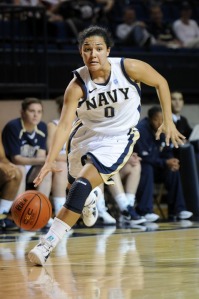 skills, which is frequently focused on in practices. Passing, on the other hand, is almost a forgotten skill. It is rare to see teams spend time on passing drills as much as dribbling. Although under-taught and under-emphasized, it is just as important. Depending on the situation, dribbling could be a better option to passing and vice versa.
skills, which is frequently focused on in practices. Passing, on the other hand, is almost a forgotten skill. It is rare to see teams spend time on passing drills as much as dribbling. Although under-taught and under-emphasized, it is just as important. Depending on the situation, dribbling could be a better option to passing and vice versa.
Dribbling is the main way to get the basketball from one spot to another through one fluid motion. As mentioned in a post about rules of the game, a player is not allowed to dribble the ball after it has already been picked up after already dribbling or attempting to dribble with two hands. This is called a double dribble and results in the other team gaining possession. The best method for successfully dribbling the ball in a controlled manner is to use the pads of your fingers and keeping the ball low to the ground. The pads of your fingers should be spread out and relaxed making contact with the ball. Your wrist should be pushing the basketball, and your forearm should be moving up and down.
Skilled ball handlers typically keep the ball low to the ground to prevent defenders from making a steal, as well as keep their opposite arm up as extra protection. Some players also make use of a high dribble, but this is only used when there is not a defender in close proximity. The high, which only comes waist-high, is considered the normal dribble, but there aren’t many instances where a player doesn’t have a defender close by to make use of such dribble.
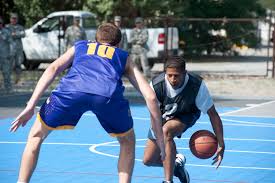 As a player increases in skill level, he/she might have the ability to dribble behind the back, between the legs, easily change dribbling speeds, and switch hands. The most important skills out of these is dribbling speeds and switching hands. Having the ability to dribble slow, fast, and anywhere in between opens up more options offensively for the player controlling the ball. In an instance, he/she can decide to pull up (shoot), pass, or drive the ball. Personally, I think this skill is only second in importance compared to the ability to switch hands.
As a player increases in skill level, he/she might have the ability to dribble behind the back, between the legs, easily change dribbling speeds, and switch hands. The most important skills out of these is dribbling speeds and switching hands. Having the ability to dribble slow, fast, and anywhere in between opens up more options offensively for the player controlling the ball. In an instance, he/she can decide to pull up (shoot), pass, or drive the ball. Personally, I think this skill is only second in importance compared to the ability to switch hands.
Each player has a dominant hand. Most people are right-handed for daily functions, which would also translate into right hand dominance in basketball. I, however, am left hand dominant in basketball even though I use my right hand for everything else. This made switching hands while dribbling and for lay-ups an easy skill to develop and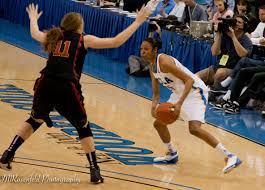 perfect. However, most are consistently right-handed making it more difficult to control the ball with their less dominant hand. Just like with the speed of dribbling, switching hands allows the ball handler with more options and more space to use on the court. Switching hands also allows you to throw off your opponent allowing you a few extra seconds to get ahead in the opposite direction.
perfect. However, most are consistently right-handed making it more difficult to control the ball with their less dominant hand. Just like with the speed of dribbling, switching hands allows the ball handler with more options and more space to use on the court. Switching hands also allows you to throw off your opponent allowing you a few extra seconds to get ahead in the opposite direction.
Passing, as said, is another way to get the ball from one end of the court to the other. This is especially true in a scenario where the opposing team is pressing – playing defense the length of the court instead of just half. Typically, passing should be done quickly and with power. Passing slowly allows the defense to easily defend and follow the ball, while quicker passes are more likely to throw off your opponents. Power behind a pass is also key because it prevents any steals. A defender can easily read and steal a slow pass because it is not getting from point A to point B quickly. However, the reverse is also true. You don’t want to pass the ball harder than your teammates can catch it.
There are two ways to pass a basketball: air pass and bounce pass. Typically a chest pass is the best pass to use in all scenarios to efficiently give your teammate the ball. This is when you hold the ball at your chest and use the pads of your finger and your wrists to push the ball outward to a team member. Accuracy and speed are important in a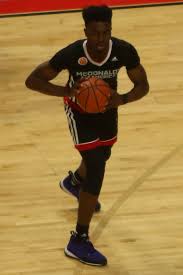 successful chest pass. If done to soft or slow, the ball might not reach the other player, or a defender could easily steal. Another air pass is the overhead pass. This is typically only used when the ball is being passed in bounds to the point guard close to half court if there are no options near the basket. An overhead pass can also be used to pass the ball from the left side of the court to the right and vice versa. This is called a skip pass, but is dangerous. If not done precisely, you run the risk of the other team anticipating the pass and stealing for possession.
successful chest pass. If done to soft or slow, the ball might not reach the other player, or a defender could easily steal. Another air pass is the overhead pass. This is typically only used when the ball is being passed in bounds to the point guard close to half court if there are no options near the basket. An overhead pass can also be used to pass the ball from the left side of the court to the right and vice versa. This is called a skip pass, but is dangerous. If not done precisely, you run the risk of the other team anticipating the pass and stealing for possession.
The bounce pass is an alternative to an air pass if a teammate is being closely defending. This is usually in scenarios when a guard is trying to get the ball to a forward who is posting up close to the basket. Since you and your teammate are both being closely guarded, a chest pass won’t work. Here, you want to judge the distance between you and the player who will receive the ball, and powerfully bounce the ball so it hits the court 3/4 away from the receiver. Using your wrists to create power behind the pass will lead to a successful bounce pass. Sometimes a little more effort is required depending on how tough the defense is. Another version of a bounce pass is the wrap around. This requires you to plant one foot firmly on the ground (your pivot foot) while using the opposite leg and foot to step around the defender. This allows you to create space to make an entry pass to a forward posted underneath the basket.
As a player practices to build up more skill, other types of advanced passes can be used to create more options offensively. There is also the baseball pass, dribble pass, behind-the-back pass, and the pick and roll pass. The baseball pass consists of throwing the ball with one hand using the same motion you would with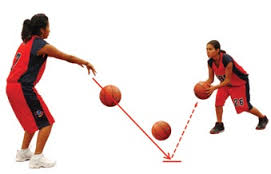 a baseball. The dribble pass is a quick pass completed off the dribble. Unless you have developed advanced ball handling skills with precise control, this pass could be an easy pick for defenders. The same goes for a behind-the-back pass; you must be able to control the ball with this type of dribble before mastering this type of pass. Finally, the pick and roll pass is used when executing a pick and roll play. This consists of a forward typically setting a pick for a guard to block a defender. A play and pass like this takes precision and communication from team members.
a baseball. The dribble pass is a quick pass completed off the dribble. Unless you have developed advanced ball handling skills with precise control, this pass could be an easy pick for defenders. The same goes for a behind-the-back pass; you must be able to control the ball with this type of dribble before mastering this type of pass. Finally, the pick and roll pass is used when executing a pick and roll play. This consists of a forward typically setting a pick for a guard to block a defender. A play and pass like this takes precision and communication from team members.
Both of these skills are important to develop for players who want to develop their personal game overall. They also are basic skills that are mistakenly taken for granted. Even if you think you know how to do them, always set aside a little time to practice. Sometimes going back to basics are the best way to step up your game.
For “How To Videos” to see exactly what this post is about, click here: Dribbling or Passing


